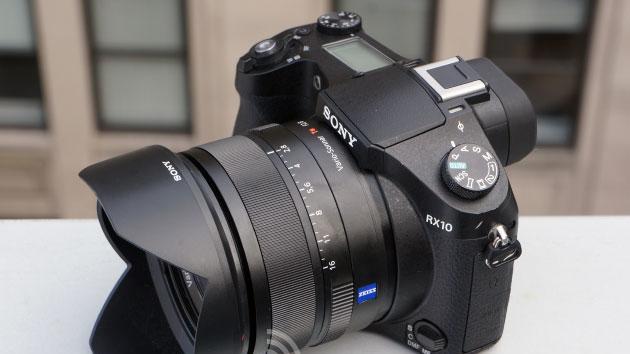sonyrx10
Latest

A first look at Sony’s super-fast RX10 IV zoom camera
Sony just announced its latest flagship point-and-shoot at an event in New York City, the RX10 IV. The new camera, a successor to last year's RX10 III, again comes with a 24-600mm (35mm equivalent) f/2.4-4 Zeiss Vario-Sonnar T* lens and a 1-inch, 20.1-megapixel stacked CMOS sensor. In terms of design, the RX10 IV is basically identical to its predecessor, featuring mode and exposure dials, a 3-inch LCD screen and an OLED viewfinder. Here's where it really shines, though: Sony says this zoom shooter sports the "world's fastest" autofocus speed of 0.03 seconds, complemented by 24fps continuous shooting (with full AF/AE tracking) and 4K (3,840 x 2,160) movie recording at 24 or 30fps.

Sony's RX10 III zoom camera steps up to a 24-600mm lens
It feels like Sony announces a new camera every other day. Following the HX-80 point-and-shoot from earlier this month, the company is now introducing the RX10 III, its latest superzoom camera. For starters, Sony's new Cyber-shot features a Zeiss Vario-Sonnar T* 24-600mm (f/2.4-4) fixed lens, an improvement over the 24-200mm found on the RX10 II. That long glass is coupled with a 20.1-megapixel, 1-inch type stacked sensor, an ISO range of 64-12,800 and a Bionz X processor, the same chip that's on other mirrorless models like the A6300.

Sony's RX10 II is a powerful superzoom camera with some quirks
Remarkable superzoom cameras are hard to come by. But every now and then, there's a standout. Take Sony's RX10 II. Introduced in June, this new shooter features a 20.2-megapixel Exmor RS BSI CMOS sensor (1-inch) and a Bionz X image processor, two of the latest high-end components from Sony. Naturally, the RX10 II's main attraction is that massive 24-200mm (35mm-equivalent) Zeiss zoom lens, which lives inside a DSLR-like body (looks-wise, it hasn't changed much compared to its predecessor from 2013). As it happens, though, Sony isn't just positioning this as a superzoom; it's also going after people who want a powerful video camera. Indeed, that's one of the things the RX10 II does best: It can shoot 4K (3,840 X 2,160) at up to 30 fps and 1080p at 24, 30 and 60 fps. Pair that with a low-light sensitivity ISO of up to 25,600 and slow-motion modes that range from 240 to 960 fps (NTSC), and you have a worthy option for video buffs.

Sony Cyber-shot RX10 review: impeccable performance and versatility make this cam an industry leader
To many photographers -- amateurs and professionals alike -- digital SLRs represent quality. The fact that you can remove the lens and swap it for another is inconsequential to those who never buy a second optic, and it's that segment of the market that Sony's targeting with its Cyber-shot RX10. Everything about the RX10 is DSLR-like -- its form factor, built-in EVF, focusing performance and image quality are all on par with many higher-end SLRs -- but its mighty 24-200mm lens is permanently attached. By opting for this comparatively inflexible design, Sony's able to deliver a constant f/2.8 aperture and very high-quality optics in a comfortable package, with a price tag far below what a similar removable lens would command, were it to exist in the first place. The result, put simply, is spectacular, but as $1,300 is at the high end of even deep-pocketed consumers' budgets, you'll want to catch our full review before making a purchase.

Sony RX10 features 1-inch 20.2MP sensor, 24-200mm constant f/2.8 lens for $1,300
Sony's growing its successful RX Cyber-shot lineup with an entirely new type of camera. The RX10 packs the same 20.2-megapixel 1-inch BSI CMOS sensor as the RX100 Mark II, and based on our experience shooting with that model, it wouldn't be unreasonable to expect excellent image quality with this cam as well. What makes this model unique, however, is the 24-200mm Zeiss lens, which offers a constant f/2.8 aperture, enabling identical exposures at both ends of the zoom spectrum. It also includes the same BIONZ X processor as the Alpha 7 and 7R, which aids in autofocus, noise reduction and detail reproduction. The RX10 is being positioned as a step-up camera for point-and-shoot users and even some DSLR owners. The camera is priced at $1,300 -- considering that you'll often spend that much for an f/2.8 zoom lens alone, it'll likely appeal to a variety of photographers. Sony's also targeting video shooters here; like the new Alphas announced today, the RX10 shoots 1080p video at 60 or 24 frames per second with full manual control, and offers uncompressed output through the HDMI port. There's also an adjustable audio level meter, a headphone and mic jack, and compatibility with the XLR-K1M adapter for even more sound input options. You can share video and still images with the built-in WiFi, which you can also use for remote shooting with Sony's Android and iOS apps. Unfortunately you're stuck with just contrast-detect AF on board, but the camera still focused quickly enough during our test. You can shoot an unlimited number of consecutive frames at 10 fps with continuous autofocus, and the three-axis image stabilization should aid in keeping shots steady. You can frame shots using the built-in OLED EVF or the 1.23M-dot 3-inch White Magic LCD, which tilts up 84 degrees or down 43 degrees for shooting at odd angles. There's a magnesium-alloy body, so it's dust and moisture-resistant as well. The Sony RX10 is expected to hit stores next month for $1,300. Update: And here are some hands-on photos from an earlier event in Hong Kong.

